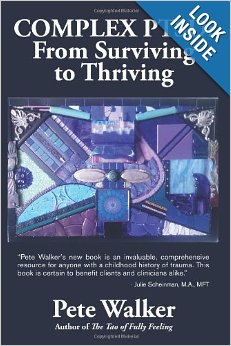COMPLEX PTSD ARTICLES
Emotional Flashback Management
Flashback Management
Codependency/Fawn Response
Shrinking the Inner Critic
Shrinking the Outer Critic
Abandonment Depression
Emotional Neglect
Grieving and Complex PTSD
The FourF's: A Trauma Typology
13 Steps Flashbacks Management
Bibliotherapy
FAQs About Complex PTSD
14 Common Inner Critic Attacks
ARTICLES FOR THERAPISTS
Using Vulnerable Self-Disclosure to Treat Arrested Relational-Development in CPTSD
Therapist Heal Thyself
Relational Healing
Treating Internalized Self-Abuse & Self Neglect
BOOK EXCERPTS:
 The Tao of
The Tao of Fully Feeling
Recovering Emotional Nature
Recovery and Self-Pity
Forgiveness: Begin With Self
Intentions for Recovery
Human Bill of Rights
Lovingly Resolving Conflict
 Homesteading in the Calm Eye of the Storm:
Homesteading in the Calm Eye of the Storm:Navigating CPTSD
My Top 10 Practices
BUY PETE'S BOOKS:

Pete Walker, M.A.
925-283-4575
PO BOX 4657,
Berkeley, CA 94704-9991
Tools For Lovingly Resolving ConflictThis is a list of techniques and perspectives I’ve gathered over the years to help couples resolve conflict as lovingly as possible. When I give it to couples that I work with, I ask them to take time at home to read it aloud together and to discuss each one as much as necessary to see if they can agree to adopt it as a guideline for handling conflict. When I first got together with my wife nine years ago, we spent considerable time on a weekend trip discussing these guidelines one at a time and airing our concerns, enthusiasms and reservation about using them. Over subsequent years, we refined our usage of them, and have evolved a communication style around our conflicts that has helped to keep our intimacy healthy and ever growing.
Two of the most common reasons that relationships break up is irreconcilable damages and irreparable damages. The latter could have been prevented in many cases if couples knew how to use timeouts judiciously. This is especially true for trauma survivors, who when flashing back, can easily lose control to the outer critic and say all kinds of deeply wounding things to each out. Survivors need to learn to recognize the signs of being activated and take timeouts to stop the bleeding caused by a critic on the rampage. Things said in the heat of activation can wound deep and engrave themselves in the psyche of the other in deply trust destroying ways. So much of this needless intimacy destruction will be prevented in both members of the couple agree that either of them can call a timeout whenever they feel too triggered to be lovingly confrontive, or are experiencing the other as flashing back into being overly aggressive. Timeouts can range from one minute to 24 hours depending on how long it takes either or both partners to achieve good enough flashback management. Timeouts work best when the person calling them nominates a time to resume conflict resolution, so that they do not becoming techniques for dodging issues. Timeouts can be used individually as a time to do the safe “angering out” techniques I describe in Chapter 5 of my book, The Tao of Fully Feeling. TransferenceIn using this list with couples, I have noticed that those who become most sophisticated around conflict resolution, have achieved significant skill with steps 19 through 21. These steps are about learning to handle transference. For trauma survivors, transference is often a type of flashback whereby we see our significant others through the lens of our earlier caretakers, and by which we project onto them a great deal of our unresolved childhood emotional pain. As such, a partner’s minor complaint might trigger a cauldron of rage, fear and/or shame left over from decades of mother’s scalding and rejecting criticism, or a failure to say what we were hoping to hear may stir up the pain of decades of an aloof, detached father’s neglect. The composition of most conflicts that I witness in my office eventually prove to be 90% re-experienced pain from the past and only 10% from what actually just happened. Said more simply, conflict flashes individual back in a way that makes them emotionally and unconsciously view their partners as if the are their abusive/neglectful parents. Harville Hendrix’s Getting The Love You Want, is a wonderful guide for not only working through this ubiquitous dynamic, but also using it to actually recover from our childhood wounds and enhance our intimacy. In my experience, the vast majority of conflicts between consenting adults involve a dynamic where both people play a part and have some responsibility for a disruption in their loving connection. Truly healing resolutions to conflict typically occur when each partner owns and expresses apology about their part. For really high level resolution this usually includes an apologetic reference to one’s transference; e.g., “I’m sorry for the amount of charge I had in expressing my disappointment. While I believe I have a fair complaint, the intensity with which I expressed it was out of whack. I’m sorry I responded to you as if you were my constantly withholding mother.” |

